Christmas Tree: Origins, History, and Symbolism

Every year people all across the globe celebrate the Christmas season with all sorts of lights and decorations. But no holiday decoration is more iconic than the Christmas tree. But have you ever wondered how the Christmas tree came to be such a pivotal part of our holiday festivities? And why do we decorate trees to celebrate Christmas? In this guide, we will show you the origins, history, and symbolic meanings behind the Christmas tree, along with the significance of its various decorations.
How did Christmas trees start?
Nowadays, the Christmas tree represents Jesus Christ’s birth and resurrection. But before the advent of Christianity, evergreen branches as a tradition already started. In early times, people decorated their homes during the winter with pine, spruce, and fir trees, and hung evergreen branches decorated with fruit and candles boughs over their doors and windows as a symbol of hope.
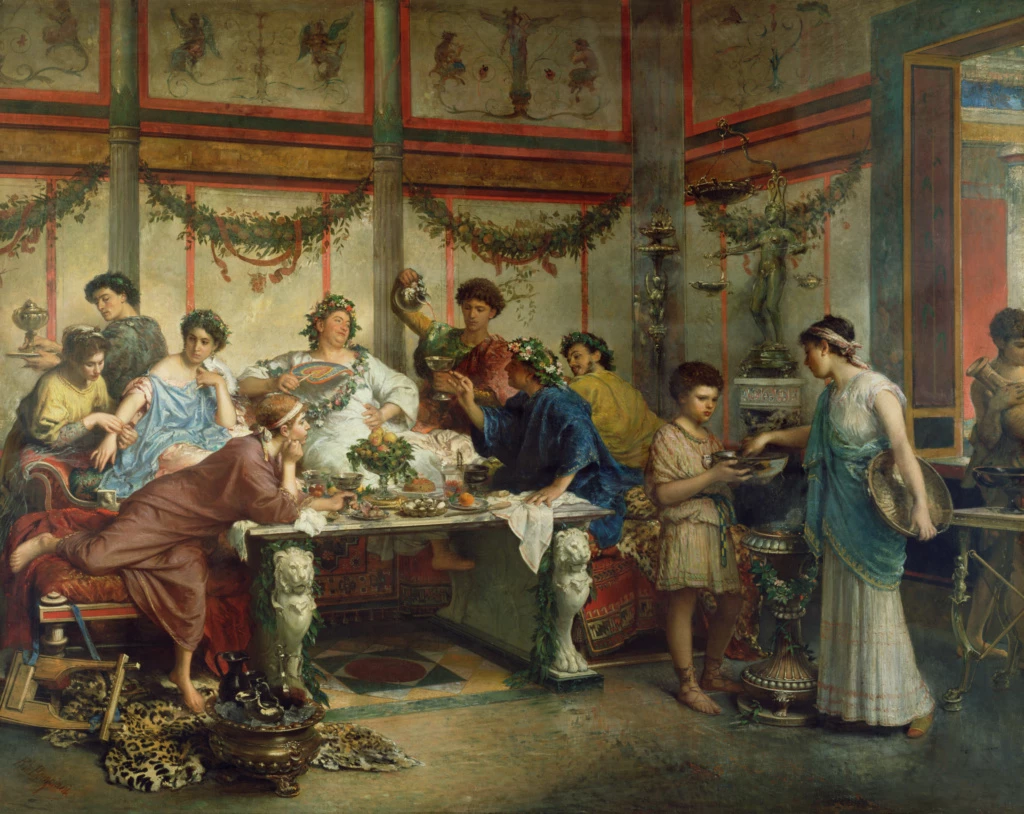
Roberto Bompiani (Italian (Roman), 1821 – 1908), Getty Museum
The origin of the modern Christmas tree-a German tradition
The origin of the modern Christmas tree has been debated; however, it is a widely held belief that Germany is the likeliest place of origin, cause among the many accounts claiming to explain the origin of the Christmas tree, the three most popular are related to Germany, more or less.
The first story is about St Boniface, an eighth-century bishop.
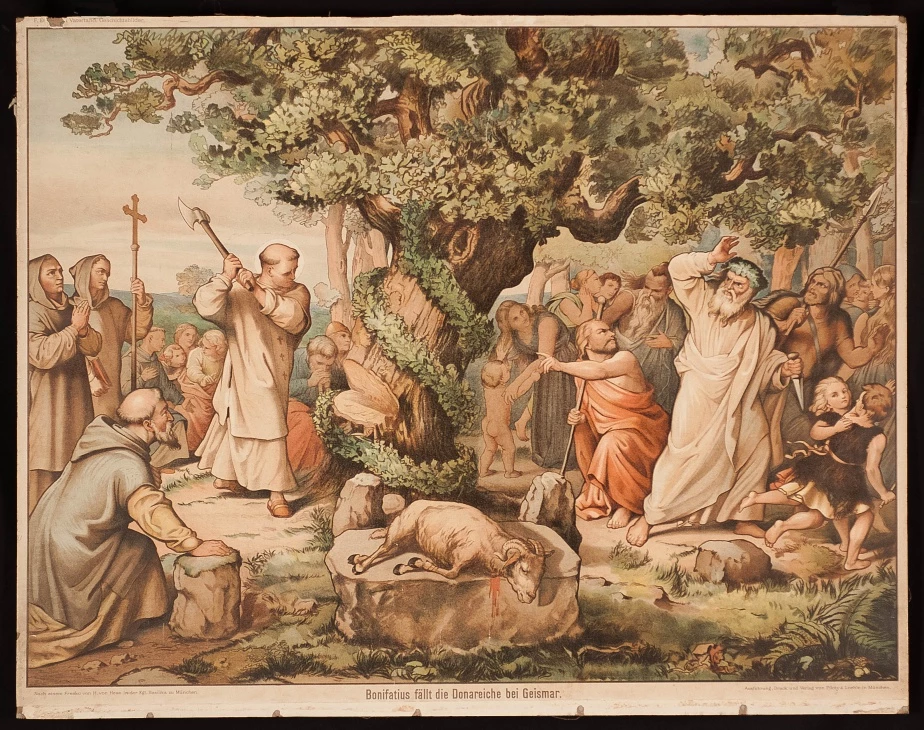
He used to spread the Christian faith as a missionary of the Roman Church in Germany. After a successful period of evangelization, he travelled to Rome to meet Pope Gregory II. After a long absence, he returned to Germany, on Christmas Day, 723. When he found that the Germans had reverted to their former idolatry of the pagan gods, and were about to celebrate the winter solstice by sacrificing a young man under Odin’s sacred oak tree, he took up an axe and bravely chopped down the tree. Legend has it that on the first stroke of the axe, a strong gust of wind instantly blew the tree down. The Germans realized that it was the hand of God and humbly asked Boniface how they should celebrate Christmas. Boniface pointed to a small fir tree that miraculously remained upright and intact beside the debris and broken branches of the fallen oak. Boniface was familiar with the popular custom of bringing home evergreens in the winter and asked everyone to bring home a fir tree. The tree symbolized peace, and as an evergreen, it also symbolized eternal life; with its top upwards, it also symbolized heaven, the abode of God.
The second story is about the “tree of paradise” of medieval mystery plays in Germany.
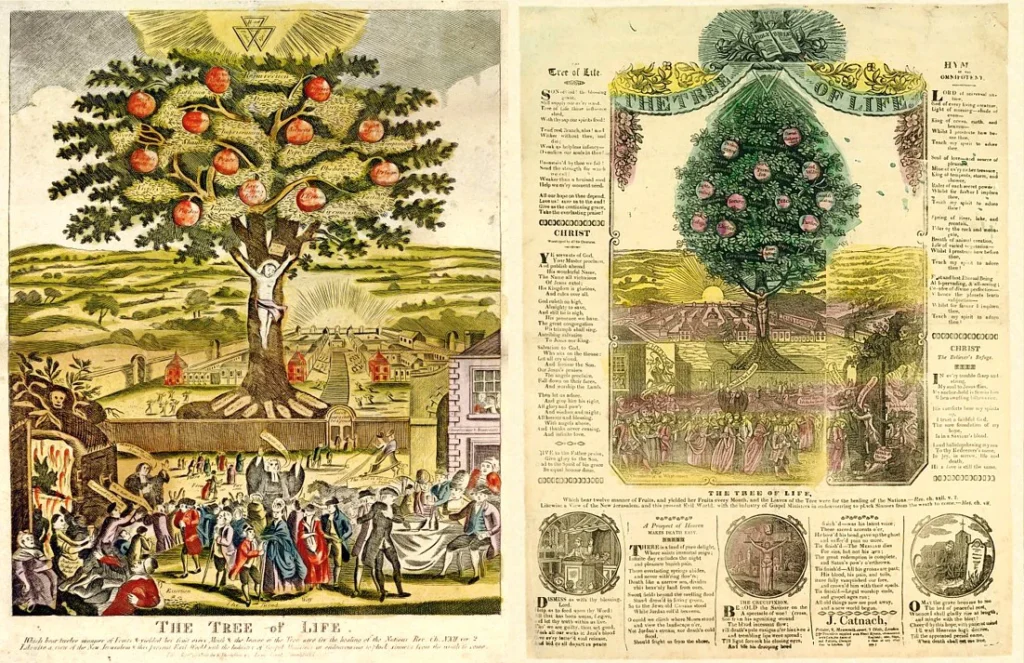
These plays were performed on 24 December. It begins with the creation of mankind, acts out the first sin, and shows the expulsion of Adam and Eve from Paradise (the Garden of Eden). It ends with the promise of a coming savior, which makes the play particularly popular at Christmas time. In the play, the Garden of Eden is usually represented by a fir tree laden with apples.
The third story is about Martin Luther.
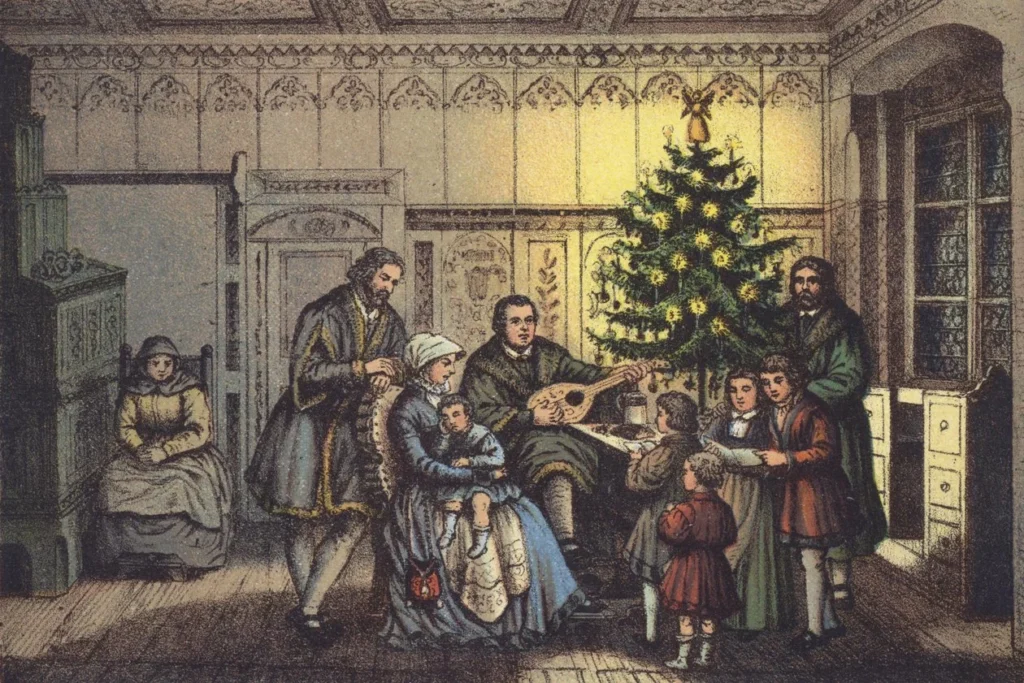
He was a Protestant reformer in the 16th century. One winter evening, Luther was allegedly walking home and was struck by the beauty of twinkling stars shining in the moonlight among the evergreens. To recreate the scene for his family, he placed a tree in his room and decorated lighted candles on its branches.
What is the history of the Christmas tree?
Ancient Traditions
Tree worship was common among European pagans, it is a custom of ancient Egyptians, Romans, and Hebrews to use evergreens, garlands, and wreaths to symbolize eternal life.
The first Christmas start
Christmas started on December 25, 336 A.D., when the first Christian Roman Emperor, Constantine, was in charge. After some time had passed, Pope Julius I announced that the birth of Jesus would be commemorated on December 25.
Christmas began to be widely celebrated
Christmas began to be widely celebrated with a specific liturgy in the 9th century but did not attain the liturgical importance of Good Friday or Easter, the other two major Christian holidays.
The first recorded Christmas tree
It is recorded that Christmas trees were first used in the 16th century by German Lutherans. There are records of one being placed in Strasbourg Cathedral in 1539 under the leadership of the Protestant reformer Martin Bussel.
Christmas tree with candles
Protestant Reformer Martin Luther added the first lit candle to the Christmas tree.
Christmas tree topper
The tradition of placing tree toppers on Christmas trees dates back to early 17th century Germany. The earliest tree toppers were usually statues of the baby Jesus, with apples and gingerbread decorating the trees. Another early tradition was to place a large candle at the top of the tree, representing the Star of Bethlehem. As this tradition spread to other countries, angel and star decorations became popular.
The first records of Christmas tree in the USA
As early as 1747, the Moravian Germans of Pennsylvania had a community tree in the shape of a wooden pyramid decorated with candles.
Christmas trees began to be introduced into American families.
In 1804, American soldiers stationed at Fort Dearborn (now Chicago) dragged Christmas trees from the surrounding woods to their barracks during Christmas. Christmas trees began to be introduced into American families ever since.
Christmas trees became widely known outside of Germany
A famous photo of Queen Victoria and Prince Albert posing next to a Christmas tree caught the attention of people all over the world. In those days, Queen Victoria wasn’t just a queen, she was also a fashion icon, so everything she did became fashionable. After the photo of the Queen and her family posing in front of a decorated tree was printed, Christmas trees became all the rage in the Western world!
The first retail Christmas tree lot in the USA
1851, Mark Carr opened a retail Christmas Tree lot in New York City, the first in the United States.
The Christmas tree in the White House
1856, Franklin Pierce, our 14th President, brings the first Christmas Tree into the White House.
Christmas becomes a federal holiday
In 1870, Christmas became an official Federal holiday when President Ulysses S. Grant made it so in an attempt to unite north and south.
Father of Electric Christmas Tree Lights
Before the advent of electric Christmas lights, people used candles to light their Christmas trees. This practice was dangerous and led to many home fires. In 1882, Edison’s friend and partner, Edward H. Johnson, assembled the first string of electric Christmas tree lights. He hand-wired 80 bulbs and wrapped them around the tree. The tree not only lights up electrically but also rotates.
Christmas tree Decorations Introduced to the U.S.
In 1890, Christmas tree decorations began to be imported from Germany to the United States. With electric lights, the trees could shine all day long, and soon they became a common sight in city centers, churches, and towns across the United States!
Artificial Christmas Trees
The first artificial Christmas trees appeared at the end of the 19th century in Germany. At that time, Germany was suffering from massive deforestation, and a more environmentally friendly alternative was needed. Then in 1920, the first artificial Christmas trees (made from feathers dyed green) were imported to the United States.
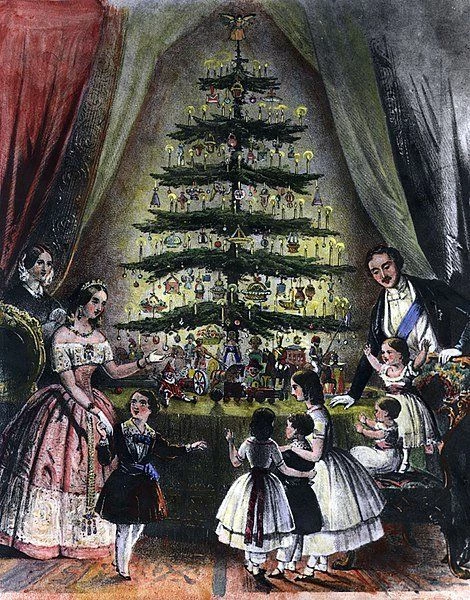
in 1848
What does the Christmas tree symbolize?
The symbolism of Christmas has evolved over time and with the intermingling of cultures.
In the early days, the Christmas tree remained green all year round, representing eternal life. The ancient Romans, Egyptians, and pagans valued the evergreen as a symbol of life amidst the winter’s cold and darkness.
With the spread of Christianity, the Christmas tree was gradually given a religious meaning. It represents the birth and resurrection of Jesus Christ. The shape of the tree was interpreted as symbolizing the Trinity (Father, Son, and Holy Spirit). The branches and bushes of the tree could symbolize eternal life and Christ’s crown of thorns, while a lit Christmas tree could represent Christ as the light in the darkness.
By now, Christmas trees not only have this religious meaning but also symbolize unity and family. Decorating a Christmas tree is a communal activity that brings family and friends together during the festive season. It represents the gathering of loved ones and the creation of memories.
Conclusion
The Christmas tree’s journey from a pagan ritual to a global holiday has transcended cultures, religions, and centuries to become a universal symbol of the holiday season. Whether Christmas is a time for expressing religious beliefs, enjoying food, laughter, and presents with family and friends, or both, the Christmas tree is at the heart of many family celebrations! Merry Christmas!
